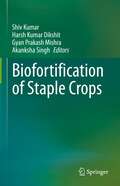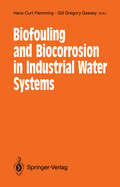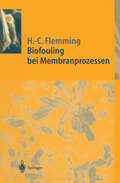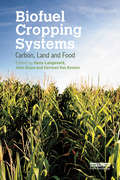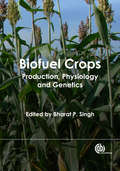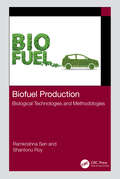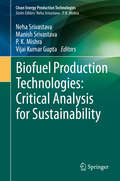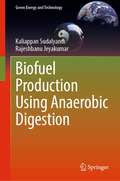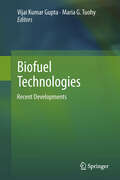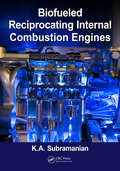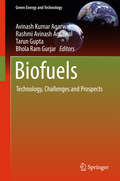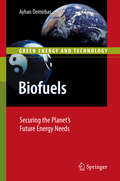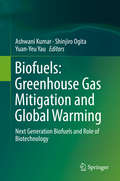- Table View
- List View
Bioformulations: for Sustainable Agriculture
by Naveen Kumar Arora Samina Mehnaz Raffaella BalestriniMore than a century has passed since the first bioformulations were introduced to the market. But there is still much to be done, explored and developed. Though bioformulations offer green alternatives and are important for sustainable agriculture, they make up only a small fraction of the total additions used to enhance crop yields or protect them from pests. There is a great need to develop bioformulations that can promote confidence among end users; accordingly, it is imperative that bioformulations to replace chemicals be reliable and overcome the shortcomings of the past.Bioformulations: for Sustainable Agriculture discusses all the issues related to the current limitations and future development of bioformulations. It examines in detail those bioformulations that include biofertilizers and biopesticides (also commonly known as bioinoculants), presenting a global picture of their development. Further chapters address diverse microbes that are already being or could be used as bioformulations. The book also discusses the techniques, tools and other additions required to establish bioformulations as trustworthy and global solutions. It assesses the types of bioformulations currently available on the market, while also considering the future roles of bioformulations, including the reclamation of marginal and polluted soils. Further, it discusses the current legislation and much-needed amendments. Overall the book provides a comprehensive outlook on the status quo of bioformulations and the future approaches needed to improve them and achieve sustainable agriculture and food security without sacrificing the quality of soils. This will be extremely important in offering chemical-free foods and a better future for generations to come.
Biofortification in Cereals: Progress and Prospects
by Altafhusain Nadaf Rupesh Deshmukh Humira Sonah Waquar Akhter Ansari Kashmir SinghThe book addresses recent advances in biofortification using different approaches like foliar fertilizer, plant breeding, and genetic engineering as well as its utilization for improvement of nutritional quality of cereals. The content compiled is contributed by the renowned scientists actively working in the area of the cereal biofortification. This is an authentic, reliable, and exhaustive compilation bringing together the technological advancements, fundamental principles, and applicability of scientific innovations in biofortification. It also discusses policies and regulations for the implication of various strategies. It is useful reading material for researchers and students in the field.
Biofortification of Food Crops
by Ummed Singh C S Praharaj S S Singh N P SinghThe chapters presented in this book ‘Biofortification of Food Crops’ depict how agricultural technological interventions have true role in alleviating malnutrition. This book highlights the role of multidisciplinary approaches to cope up with the challenges of micronutrient malnutrition or hidden hunger which is an alarming public health issue in most parts of the world including India. In this endeavour, different biofortification approaches such as agronomic (or ferti-fortification), breeding, biotechnological, physiological, microbial etc. has fulfilled their different mandates of nutrient enrichment of food crops including cereals and pulses. The contents of the book proves that biofortified plants have adequate potential to nourish nutrient depleted soils, help increase crop productivity and provide nutritional benefits to plants, humans and livestock. The content and quality of information presented in this book will definitely provide multiple novel ideas of advance techniques and will stimulate innovative thoughts and directions amongst researchers and policy makers in the field of biofortification. In addition, the contributions presented in the book will be a good source of background knowledge and technical know-how to educate the readers about biofortification. The authors hope that the book entitled “Biofortification of Food Crops” would provide a suitable platform in our collective efforts for an appropriate dialogue among the scientists, researchers, entrepreneurs, policy makers and farmers in reducing the budding issues of malnutrition through novel approaches and means.
Biofortification of Staple Crops
by Shiv Kumar Harsh Kumar Dikshit Gyan Prakash Mishra Akanksha SinghThis edited book brings together comprehensive information on various aspects of the biofortification of staple crops. It addresses the present status of food and nutritional security and highlights the importance of micronutrients in human health, a historical account of biofortification, current approaches and challenges, crop-specific biofortification efforts and various breeding approaches, including conventional, and genomics enabled improvement. It also explains the efficacy of biofortification, bioavailability, and future thrust. It is an inclusive source of information on different aspects of micronutrients in crops of global importance. Malnutrition is a serious global issue, with millions of people being undernourished, several suffering from micronutrient deficiencies, and the adult population struggling with obesity. Despite significant economic progress, South Asia and Sub-Saharan Africa are still home to an undernourished population. Nutrition-related health problems are related to hidden hunger and are widespread in the developing world. Women and preschool children are more vulnerable. Even though global food production has increased manifolds, estimates indicate that over 60% of the world’s population is deficient in essential micronutrients such as iron, zinc, iodine, and selenium, often causing health problems and developmental delays. Linking agricultural production with human nutrition and health is crucial for ensuring nutrition security. Much research has been carried out to assess genetic diversity related to micro-nutrients in staple crops, their bioavailability, and the efficacy of biofortified germplasm. Biofortified varieties developed in different crops through conventional breeding are being up-scaled for reducing the micronutrient deficiencies in other countries. This book is a ready reference for researchers, academicians, extension personnel, policymakers, students, and value chain stakeholders engaged in agriculture, nutrition, and health sectors promoting nutrition-sensitive diets.
Biofouling and Biocorrosion in Industrial Water Systems: Proceedings of the International Workshop on Industrial Biofouling and Biocorrosion, Stuttgart, September 13–14, 1990
by Gill Gregory Geesey Hans-Curt FlemmingMicrobial growth and contamination ("Biofouling") in water systems represents a significant threat to the quality of waters produced for the microelectronic, pharmaceutical, petroleum, paper, food and other manufacturing industries. Biofouling can lead to biologically induced corrosion ("Biocorrosion"), which can cause severe damage to the equipment. Both biofouling and biocorrosion are frequently not recognized in time, underestimated, or linked with the wrong causes. The book represents a new approach by introducing biofilm properties and dynamics as basic principles of biofouling and biocorrosion, thus providing a better understanding and the means of fighting the undesired effects of biofilms. The most important features are: Case histories of biofouling in water treatment.- Detection and monitoring of biofouling.- Reverse osmosis membrane biofouling.- Biocide efficacy and biofouling control.- Plant design considerations for preventing biofouling.- Case histories of biocorrosion.- Detection, monitoring, control and prevention of biocorrosion.- Fundamentals of biofouling and biocorrosion mechanisms.
Biofouling Methods
by Sergey Dobretsov Jeremy C. Thomason David N. WilliamsBiofouling Methods provides a “cook book” for both established workers and those new to the field. The methods included in this important new book range from tried and tested techniques to those at the cutting edge, encompassing the full diversity of this multidisciplinary field. The book covers methods for microbial and macrofouling, coatings and biocides, and ranges from methods for fundamental studies to methods relevant for industrial applications. There is an emphasis on answering questions and each chapter provides technical methods and problem-solving hints and tips. Bringing together a wealth of international contributions and edited by three internationally known and respected experts in the subject Biofouling Methods is the essential methodology reference in the field for all those working in the antifouling industry including those involved in formulation of antifouling products such as paints and other coatings. Aquatic biologists, ecologists, environmental scientists and lawyers, marine engineers, aquaculture personnel, chemists, and medical researchers will all find much of interest within this book. All universities and research establishments where these subjects are studied and taught should have copies of this important work on their shelves.
Biofouling Methods
by Sergey Dobretsov David N. Williams Jeremy C. ThomasonBiofouling Methods provides a “cook book” for both established workers and those new to the field. The methods included in this important new book range from tried and tested techniques to those at the cutting edge, encompassing the full diversity of this multidisciplinary field. The book covers methods for microbial and macrofouling, coatings and biocides, and ranges from methods for fundamental studies to methods relevant for industrial applications. There is an emphasis on answering questions and each chapter provides technical methods and problem-solving hints and tips. Bringing together a wealth of international contributions and edited by three internationally known and respected experts in the subject Biofouling Methods is the essential methodology reference in the field for all those working in the antifouling industry including those involved in formulation of antifouling products such as paints and other coatings. Aquatic biologists, ecologists, environmental scientists and lawyers, marine engineers, aquaculture personnel, chemists, and medical researchers will all find much of interest within this book. All universities and research establishments where these subjects are studied and taught should have copies of this important work on their shelves.
Biofuel Cropping Systems: Carbon, Land and Food
by J.W.A. Langeveld John Dixon Herman Van KeulenChoosing appropriate practices and policies for biofuel production requires an understanding of how soils, climate, farm types, infrastructure, markets and social organisation affect the establishment and performance of these crops. The book highlights land use dynamics, cultivation practices related to conversion and wider impacts. It explores how biofuel production chain development is steered by emerging technologies and management practices and how both can be influenced by effective policies designed to encourage sustainable biofuel production. The book highlights major biofuel production chains including: cane cultivation in Brazil corn ethanol in the USA wheat and rapeseed in Europe oil palm in the Far East cane in Asia and Africa SRC and other lignocellulosic crops. In each case the development, cropping systems and impacts are discussed, system dynamics are shown and lessons drawn for the way things could or should change. Biofuel Cropping Systems is a vital resource for all those who want to understand the way biofuels are produced and how they impact other elements of society and especially how improvements can be made. It is a handbook for students, biofuel producers, researchers and policymakers in energy and agriculture.
Biofuel Cropping Systems: Carbon, Land and Food
by Hans Langeveld John Dixon Herman Van KeulenChoosing appropriate practices and policies for biofuel production requires an understanding of how soils, climate, farm types, infrastructure, markets and social organisation affect the establishment and performance of these crops. The book highlights land use dynamics, cultivation practices related to conversion and wider impacts. It explores how biofuel production chain development is steered by emerging technologies and management practices and how both can be influenced by effective policies designed to encourage sustainable biofuel production. The book highlights major biofuel production chains including: cane cultivation in Brazil corn ethanol in the USA wheat and rapeseed in Europe oil palm in the Far East cane in Asia and Africa SRC and other lignocellulosic crops. In each case the development, cropping systems and impacts are discussed, system dynamics are shown and lessons drawn for the way things could or should change. Biofuel Cropping Systems is a vital resource for all those who want to understand the way biofuels are produced and how they impact other elements of society and especially how improvements can be made. It is a handbook for students, biofuel producers, researchers and policymakers in energy and agriculture.
Biofuel Crops: Production, Physiology and Genetics
by Kossonou Guillaume Anzoua Surinder S Banga Gary Stephan Banuelos Natalie S Betts Sujata Bhargava T K Biswas Serge Bracconnier Rachel A Burton Caitlin S Byrt Isabel S Carvalho M Czako Karaj Singh Dhillon Ismail Dweikat C Eynck N K Fageria K C Falk Naser Farrokhi J G Isebrands John H Fike Leslie H Groom Anna Hale S Hemaiswarya Ratikanta Maiti Kurt H Johnsen Eric J Jokela Masazumi Kayama Bill Kovarik C Ganesh Kumar Christopher Q Lan L Marton Steven E McKeand P J Minogue L A Moraes A Moreira K Muthukumarappan C Dana Nelson Eric Obeng David J Parrish Jagannath Vishnu Patil Gary F Peter Somashekhar Punnuri R Raja P Srinivasa Rao R Ravikumar Belum V Reddy Donald L Rockwood Robert B Rummer Pratik Satya Ralph Sims Hari P Singh Suhas P Wani Peer M Schenk Holger Schuhmann A V Umakanth Ryan P Viator Martin Weih C M Williams Toshihiko YamadaProviding comprehensive coverage on biofuel crop production and the technological, environmental and resource issues associated with a sustainable biofuel industry, this book is ideal for researchers and industry personnel. Beginning with an introduction to biofuels and the challenges they face, the book then includes detailed coverage on crops of current importance or with high future prospects, including sections on algae, sugar crops and grass, oil and forestry species. The chapters focus on the genetics, breeding, cultivation, harvesting and handling of each crop.
Biofuel Production: Biological Technologies and Methodologies
by Ramkrishna Sen Shantonu RoyBiofuels and bioenergy have emerged as an alternative option based on their sustainability, concomitant waste treatment, and site-specific flexibility. This book encompasses all the knowhow of different biofuel production processes through biological methods. It describes recent advancements in all major biofuel technologies such as biohydrogen, biomethane, bioethanol, syngas and so forth. Related protocols supported by schematic representation are included, encompassing comprehensive up-to-date scientific and technological information in biofuels and bioenergy. Features: Includes practical approaches focused on process design and analysis in biofuel production via biological routes Discusses kinetic equations of different microbial systems Provides comprehensive coverage of biochemical kinetics and equations related to biofuel process Describes protocols for setting up of experiments for pertinent biofuel technologies Emphasis on practical engineering approaches and experiments This book is aimed at researchers and graduate students in chemical, biochemical and bioprocess engineering, and biofuels.
Biofuel Production: Biological Technologies and Methodologies
by Ramkrishna Sen Shantonu RoyBiofuels and bioenergy have emerged as an alternative option based on their sustainability, concomitant waste treatment, and site-specific flexibility. This book encompasses all the knowhow of different biofuel production processes through biological methods. It describes recent advancements in all major biofuel technologies such as biohydrogen, biomethane, bioethanol, syngas and so forth. Related protocols supported by schematic representation are included, encompassing comprehensive up-to-date scientific and technological information in biofuels and bioenergy. Features: Includes practical approaches focused on process design and analysis in biofuel production via biological routes Discusses kinetic equations of different microbial systems Provides comprehensive coverage of biochemical kinetics and equations related to biofuel process Describes protocols for setting up of experiments for pertinent biofuel technologies Emphasis on practical engineering approaches and experiments This book is aimed at researchers and graduate students in chemical, biochemical and bioprocess engineering, and biofuels.
Biofuel Production Technologies: Critical Analysis for Sustainability (Clean Energy Production Technologies)
by Neha Srivastava Manish Srivastava P. K. Mishra Vijai Kumar GuptaProduction and utilization of sustainable energy toward maintaining a clean environment is a major challenge. At the same time, the continued depletion of fossil fuels and the global dependency on non-renewable fuels is a chief concern. Moreover, the long-term economic and environmental issues associated with the high utilization of fossil fuel, such as global warming, are also important, particularly in the context of the predicted increase in the global population to around 5 billion by 2050. In recent years, researchers have been investigating alternative, renewable fuels to replace fossil fuels. Of the various options, biofuels are especially attractive due to their low production costs and the fact that they are pollution free. Also known as transportation fuels, their energy is derived from biological resources or through the biological processes. Biofuels such as biohydrogen, biomethane, biogas, ethanol and butanol offer a number of advantages and can be economically produced from cellulosic biomass. As such, they can play a vital role in sustainably meeting future energy demands. Biofuels have the potential to become a global primary energy source, offering significant reductions in greenhouse gas emissions as well as opportunities to increase economic and social development in rural communities and reduce the problems associated with waste disposal. However, low yields and lack of process technology are some of the aspects that need to be addressed. This book offers an overview of existing biofuels and the technologies to solve the problems associated with their practical implementation. Evaluating the biofuel options and discussing the opportunities and risks in relation to resources, technologies, practices, markets and policy, it provides insights into the development of economically viable bioenergy industries.
Biofuel Production Using Anaerobic Digestion (Green Energy and Technology)
by Kaliappan Sudalyandi Rajeshbanu JeyakumarThis book provides lucid and instructive information about waste biomass, its potential, and the methods employed in energy generation. Topics covered include the basic principles, applications, recent advances, and the technical and economic considerations of waste-to-energy (WTE) technology. It highlights and elucidates essential concepts, mechanisms, applications, and useful outcomes of WTE technologies. In addition, it also provides a few example problems with design data for energy generation from waste biomass which will help the readers to understand the basics of WTE technologies. The book is structured with an overview at the start of each chapter presenting an outline of its content and a list of relevant discussions targeted toward readers. To illustrate the types of waste biomass, principles, and process of various thermal and biochemical process technologies, over 90 illustrations including graphs, diagrams, and photographs are provided. To help the readers improve their knowledge of the subject and to increase the utility of this book, the characteristics of waste biomass, operation conditions of different processes, and global status of WTE technologies are provided in tabular format. For that purpose, over 50 tables are provided. Selected references are also provided for this book. This book is primarily intended for researchers and professionals working in the area of bioenergy. It can also be used as a primary or secondary text for graduate courses and professional training programs.
Biofuel Technologies: Recent Developments
by Vijai Kumar Gupta and Maria G. TuohyBiofuels are considered to be the main potential replacement for fossil fuels in the near future. In this book international experts present recent advances in biofuel research and related technologies. Topics include biomethane and biobutanol production, microbial fuel cells, feedstock production, biomass pre-treatment, enzyme hydrolysis, genetic manipulation of microbial cells and their application in the biofuels industry, bioreactor systems, and economical processing technologies for biofuel residues. The chapters provide concise information to help understand the technology-related implications of biofuels development. Moreover, recent updates on biofuel feedstocks, biofuel types, associated co- and byproducts and their applications are highlighted. The book addresses the needs of postgraduate researchers and scientists across diverse disciplines and industrial sectors in which biofuel technologies and related research and experimentation are pursued.
Biofueled Reciprocating Internal Combustion Engines
by K.A. SubramanianBiofuels such as ethanol, butanol, and biodiesel have more desirable physico-chemical properties than base petroleum fuels (diesel and gasoline), making them more suitable for use in internal combustion engines. The book begins with a comprehensive review of biofuels and their utilization processes and culminates in an analysis of biofuel quality and impact on engine performance and emissions characteristics, while discussing relevant engine types, combustion aspects and effect on greenhouse gases. It will facilitate scattered information on biofuels and its utilization has to be integrated as a single information source. The information provided in this book would help readers to update their basic knowledge in the area of "biofuels and its utilization in internal combustion engines and its impact Environment and Ecology". It will serve as a reference source for UG/PG/Ph.D. Doctoral Scholars for their projects / research works and can provide valuable information to Researchers from Academic Universities and Industries. Key Features: • Compiles exhaustive information of biofuels and their utilization in internal combustion engines. • Explains engine performance of biofuels • Studies impact of biofuels on greenhouse gases and ecology highlighting integrated bio-energy system. • Discusses fuel quality of different biofuels and their suitability for internal combustion engines. • Details effects of biofuels on combustion and emissions characteristics.
Biofueled Reciprocating Internal Combustion Engines
by K.A. SubramanianBiofuels such as ethanol, butanol, and biodiesel have more desirable physico-chemical properties than base petroleum fuels (diesel and gasoline), making them more suitable for use in internal combustion engines. The book begins with a comprehensive review of biofuels and their utilization processes and culminates in an analysis of biofuel quality and impact on engine performance and emissions characteristics, while discussing relevant engine types, combustion aspects and effect on greenhouse gases. It will facilitate scattered information on biofuels and its utilization has to be integrated as a single information source. The information provided in this book would help readers to update their basic knowledge in the area of "biofuels and its utilization in internal combustion engines and its impact Environment and Ecology". It will serve as a reference source for UG/PG/Ph.D. Doctoral Scholars for their projects / research works and can provide valuable information to Researchers from Academic Universities and Industries. Key Features: • Compiles exhaustive information of biofuels and their utilization in internal combustion engines. • Explains engine performance of biofuels • Studies impact of biofuels on greenhouse gases and ecology highlighting integrated bio-energy system. • Discusses fuel quality of different biofuels and their suitability for internal combustion engines. • Details effects of biofuels on combustion and emissions characteristics.
Biofuels: Technology, Challenges and Prospects (Green Energy and Technology)
by Avinash Kumar Agarwal Rashmi Avinash Agarwal Tarun Gupta Bhola Ram GurjarThis book is intended to serve as a compendium on the state-of-the-art research in the field of biofuels. The book includes chapters on different aspects of biofuels from renowned international experts in the field. The book looks at current research on all aspects of biofuels from raw materials to production techniques. It also includes chapters on analysis of performance of biofuels, particularly biodiesel, in engines. The book incorporates case studies that provide insights into the performance of biofuels in applications such as automotive engines and diesel generators. The contents of the book will be useful to graduate students and researchers working on all aspects of biofuels. The book will also be of use to professionals and policymakers interested in biofuels.
Biofuels: Securing the Planet’s Future Energy Needs (Green Energy and Technology)
by Ayhan DemirbasBiofuel is a renewable energy source produced from natural materials. The benefits of biofuels over traditional petroleum fuels include greater energy security, reduced environmental impact, foreign exchange savings, and socioeconomic issues related to the rural sector. The most common biofuels are produced from classic food crops that require high-quality agricultural land for growth. However, bioethanol can be produced from plentiful, domestic, cellulosic biomass resources such as herbaceous and woody plants, agricultural and forestry residues, and a large portion of municipal and industrial solid waste streams. There is also a growing interest in the use of vegetable oils for making biodiesel. “Biofuels: Securing the Planet’s Future Energy Needs” discusses the production of transportation fuels from biomass (such as wood, straw and even household waste) by Fischer-Tropsch synthesis. The book is an important text for students and researchers in energy engineering, as well as professional fuel engineers.
Biofuels: Next Generation Biofuels and Role of Biotechnology
by Ashwani Kumar Shinjiro Ogita Yuan-Yeu YauThis timely book is a compilation of edited articles by distinguished international scientists discussing global warming, its causes as well as present and future solutions. Social and economic growth at global level is measured in terms of GDP, which requires energy inputs generally based on fossil fuel resources. These, however, are major contributors to increasing levels of CO2, causing 15 tonnes of green house gas emissions per capita. Renewable sources of energy offer an alternative to fossil fuels, and would help reduce this to the 2 tonnes of greenhouse gas emissions per capita per annum needed to achieve sustainable growth. As such, the book discusses the next-generation of biofuels and all related aspects, based on the editors’ significant investigations on biofuels over the last 30 years. It also presents the latest research findings from research work carried out by contemporary researchers. Presenting global biofuel perspectives, it examines various issues related to sustainable development of biofuels in the contexts of agriculture, forestry, industry and economic growth. It covers the 1st to 4th generation biofuels, as well as the status of biofuel resources and their potential in carbon neutral economy. Offering a comprehensive, state-of-art overview of current and future biofuels at local and global levels, this book appeals to administrators, policy makers, universities and research institutions.
Biofuels: Technologies, Policies, and Opportunities
by Sunil Kumar RenaOffering a comprehensive overview of biofuels and bioenergy systems, Biofuels: Technologies, Policies, and Opportunities describes advances in technologies and global policies around biofuels as a renewable energy source. It discusses the basics of biofuel and bioenergy systems and current status and potential challenges in developed and developing countries. The book also highlights the questions that should be asked, available options, and processes (conventional and advanced) to enhance biofuel production. Details how technological interventions can influence the operation of an effective bioenergy system. Presents information regarding renewable energy directives and global policies related to energy chains, energy models, market status, and appropriateness of technology selection for different generations of biofuel generation. Covers socio-economic aspects and techno-economic feasibility as well as a detailed life cycle simulations (LCS) approach, revealing the real constraints being faced in the biofuels sector. Helps bioenergy professionals to prepare a roadmap for day-to-day operations. Describes recent advances such as biohythane, advanced oxidation process, and nanocatalyzed pretreatment for biofuel generation from wastewater. Addresses the most commonly discussed issues in the biofuel sector and the rationales underpinning them. Written for professionals, academic researchers, decision makers, and policymakers in the biofuel sector, this book provides readers with a wide-ranging review of current research and developments in the respective field.
Biofuels: Methods and Protocols (Methods in Molecular Biology #581)
by Jonathan R. MielenzThis editor believes the public finally understands that bioenergy should be a critical new 39 component of our world’s future energy supply. While this new enlightenment might have 40 come from bioenergy’s environmentally friendly attributes and its renewable and sustain- 41 able nature, the reality is that the primary driver has been both the high cost of energy, 42 led recently by petroleum products, and the unique climatic changes such as local weather 43 events and reports of melting of ancient glaciers. I believe that much of the public under- 44 stands the primary cause of these changes is the growing demand for fossil fuels for heat- 45 ing and transportation needs driven by both population increases and dramatic economic 46 development around the globe. This increased demand, as well as global politics, has 47 impacted the costs for these energy products. At the same time, increased use of fossil fuels 48 has been liberating unprecedented levels of CO and other greenhouse gasses (GHGs) 49 2 that must be impacting the global climate. As a result, the world is looking for alternative 50 solutions. Renewable energy is one of the leading options as long as it is pursued in a sus- 51 tainable fashion. Of course, renewable energy has numerous sources, including wind, solar, 52 geothermal, ocean currents/tides, and bio-based energy. The latter category of renewable 53 energy is centered primarily on use of green plant matter, i. e.
Biofuels: Biotechnology, Chemistry, and Sustainable Development
by David M. MousdaleEvaluating a wealth of quantitative data, Biofuels: Biotechnology, Chemistry, and Sustainable Development discusses different types of biofuels, the science behind their production, the economics of their introduction to the marketplace, their environmental impacts, and their implications for world agriculture. It broadens the discussion on biofuel
Biofuels (Advances in Biochemical Engineering/Biotechnology #108)
by Lisbeth OlssonWith contributions by numerous experts



